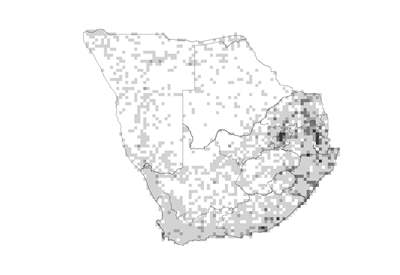 Species distribution and density. Darker squares represent higher density of members of this family. |
Introduction
Milkweed family
The family Apocynaceae has many widely differing species ranging from tall trees found in tropical rainforests and the subtropics, to succulent shrubs and small trees growing in tropical, dry and even xeric environments. There are also perennial herbs from temperate zones. Many of these plants have milky sap with some species poisonous if ingested.
Distribution
Mostly found in tropical and warm regions, but also in temperate regions. In southern Africa succulent members are more prevalent in the western, drier areas and the herbaceous members and lianas are more diverse in the moist eastern parts of the region.
Number of genera in the world
ca. 480
Number of species in the world
ca. 4 800
Number of genera in the Flora of southern Africa region
94
Number of species in the Flora of southern Africa region
787
Well-known southern African genera
Adenium, Asclepias, Brachystelma, Carissa, Ceropegia, Hoodia, Pachycarpus, Stapelia, Xysmalobium.
Growth forms
Herbs, geophytic herbs, climbers, shrubs, trees and succulents.
Habitats
Very variable habitats from arid environments to scrub, grassland, savanna, woodland and forest.
Flagship species
Pachycarpus schinzianus (cream cups; bitterwortel [A]) is a perennial herb that resprouts from a rootstock and flowers from October to December. It is a Highveld near-endemic, with its distribution centred in Gauteng. The milky latex is extremely bitter and is rubbed on animal skins before they are set out to dry. People also rub the crushed leaves on their legs to repel dogs. Uzara (this species mixed with Xysmalobium undulatum) is a well-known medicine used for diarrhoea, dysentery, to soothe afterbirth cramps and as a tonic for the cardiovascular system.
Significance of the family
Many species are popular garden plants and several genera (e.g. Adenium and Pachypodium) are grown as ornamental plants. Landolphia and other genera have been used as a commercial source of inferior rubber. The sap of Acokanthera and some Pachypodium species has been used as venom for arrow tips. Some species are sources of important medicinal compounds for treatment of cancer, high blood pressure and even psychosis. A number of taxa are utilised for the fibre contained in the stems and fruit.
Diagnostic characters
Plants with watery or milky sap. Leaves mostly opposite or in whorls, without stipules or bracts. Flowers regular , usually in umbels . Corolla 5, fused into a tube; sometimes twisted in the bud ; androecium 5, inserted on the tube, sometimes � hidden; anthers arrow-shaped and free or fused into a tube. Stamen fused with style into a column . Corona on central column. Pollen mostly packed together as pollinia . Ovary superior or half-inferior, consists of 2 carpels usually only fused at style. Fruit large, fleshy and solid, or dry follicles, or inflated, usually in divergent pairs . Seed usually with plumes or a tuft of silky hairs .
Did you know?
The compound in Hoodia gordonii responsible for the suppression of hunger is nowadays synthesised and used in weight-loss medication and supplements.